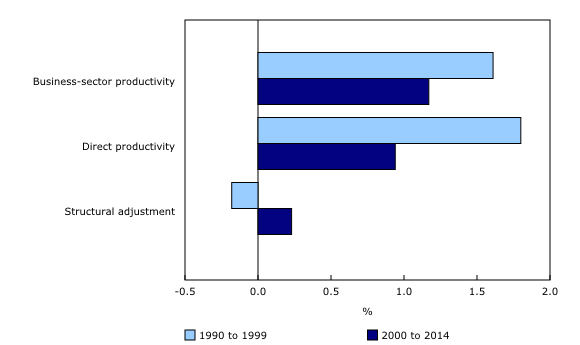Study: The industry origins of Canada's weaker labour productivity performance and the role of structural adjustment in the 1990s and 2000s
Archived Content
Information identified as archived is provided for reference, research or recordkeeping purposes. It is not subject to the Government of Canada Web Standards and has not been altered or updated since it was archived. Please "contact us" to request a format other than those available.
Released: 2016-06-13
Labour productivity growth—a key contributor to higher living standards—has deteriorated in the Canadian business sector since the 1990s.
Growth in labour productivity slowed from an annual average of 1.61% in the 1990s (1990 to 1999) to an annual average of 1.17% in the 2000s (2000 to 2014).
Direct productivity growth, which measures the contribution of changes in labour productivity within individual industries, accounted for all of the productivity slowdown. In contrast, structural adjustment, which captures the impact on productivity growth due to labour shifting among industries with different levels of productivity, slightly moderated the slowdown.
In the 1990s, all of the gains in business-sector labour productivity came from direct productivity growth (+1.80%), while structural adjustment (-0.18%) had a small tempering effect on growth. By comparison, direct productivity growth was nearly a full percentage point lower in the 2000s (+0.94%), while structural adjustment was higher and positive during this period (+0.23%), moderating the decline in overall productivity growth.
Direct productivity growth in manufacturing contributed the most to the slowdown in productivity growth in the 2000s, accounting for virtually all of the decline in labour productivity growth in the business sector. Structural adjustment in manufacturing, in turn, accounted for almost none of the business sector's slowdown. The moderate effect of structural adjustment was due to the fact that the manufacturing sector's average level of labour productivity in the 2000s was slightly higher than that of the business sector.
The finance, insurance and real estate, and mining, oil and gas industries—both high-productivity industries—also experienced a significant slowdown in direct productivity growth in the 2000s. However, the impact of the slowdown was partially offset by positive contributions from structural adjustment in both industries.
In the 2000s, the largest positive contributions to labour productivity growth (direct productivity growth and structural adjustment combined) in the business sector came from four industries: other private services; accommodation and food services; professional, science and technology services; and wholesale trade. Together, these industries contributed 0.36 percentage points to labour productivity growth in the business sector.
This positive contribution was partly offset by the negative contribution from the finance, insurance and real estate, and mining, oil and gas industries (-0.30 percentage points), leading to weaker productivity growth in the 2000s.
Note to readers
The study "The Industry Origins of Canada's Weaker Labour Productivity Performance and the Role of Structural Adjustment in the 1990s and the 2000s" is based on data available in CANSIM table 383-0021.
Products
The research paper "The Industry Origins of Canada's Weaker Labour Productivity Performance and the Role of Structural Adjustment in the 1990s and the 2000s," which is part of the Analytical Studies Branch Research Paper Series (11F0019M), is now available from the Browse by key resource module of our website under Publications.
Contact information
For more information contact us (toll-free 1-800-263-1136; 514-283-8300; STATCAN.infostats-infostats.STATCAN@canada.ca).
To enquire about the concepts, methods or data quality of this release, or to obtain a copy of the Stata program and datasets used in this study, contact Michael Willox (613-864-0098; michael.willox@canada.ca), Economic Analysis Division.
- Date modified:


